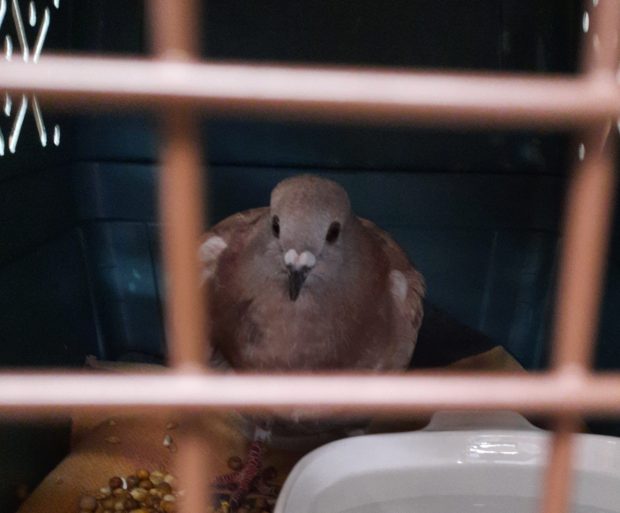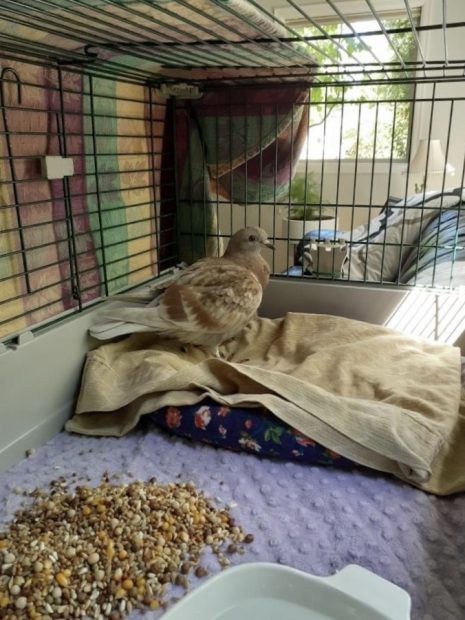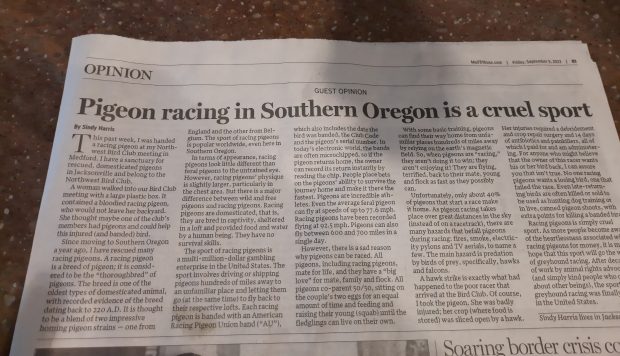Guest Post by Sindy Harris

Cary, an injured racing pigeon, found grounded & helpless
This past week, I was handed a racing pigeon at my Northwest Bird Club meeting in Medford. I have a sanctuary for rescued, domesticated pigeons in Jacksonville and belong to the Northwest Bird Club. A woman walked into our Bird Club meeting with a large plastic box. It contained a bloodied racing pigeon, who would not leave her backyard. She thought maybe one of the Club’s members had pigeons and could help this injured (and banded) bird.
Since moving to Southern Oregon a year ago, I have rescued many racing pigeons. A racing pigeon is a breed of pigeon; it is considered to be the “thoroughbred” of pigeons. The breed is one of the oldest types of domesticated animal, with recorded evidence of the breed dating back to 220 A.D. It is thought to be a blend of two impressive homing pigeon strains – one from England and the other from Belgium. The sport of racing pigeons is popular worldwide, even here in Southern Oregon.
In terms of appearance, racing pigeons look little different than feral pigeons to the untrained eye. However, racing pigeons’ physique is slightly larger, particularly in the chest area. But there is a major difference between wild and free pigeons and racing pigeons. Racing pigeons are domesticated, that is, they are bred in captivity, sheltered in a loft and provided food and water by a human being. They have no survival skills.
The sport of racing pigeons is a multi-million-dollar gambling enterprise in the United States. The sport involves driving or shipping pigeons hundreds of miles away to an unfamiliar place and letting them go (at the same time) to fly back to their respective lofts. Each racing pigeon is banded with an American Racing Pigeon Union band (“AU”), which also includes the date the bird was banded, the Club Code and the pigeon’s serial number. In today’s electronic world, the bands are often microchipped, so if the pigeon returns home, the owner can record its return instantly by reading the chip. People place bets on the pigeons’ ability to survive the journey home and make it there the fastest. Pigeons are incredible athletes. Even the average feral pigeon can fly at speeds of up to 77.6 mph. Racing pigeons have been recorded flying at 92.5 mph. Pigeons can also fly between 600 and 700 miles in a single day.
However, there is a sad reason why pigeons can be raced. All pigeons, including racing pigeons, mate for life, and they have a “big love” for mate, family and flock. All pigeons co-parent 50/50, sitting on the couple’s two eggs for an equal amount of time and feeding and raising their young (squab) until the fledglings can live on their own. With some basic training, pigeons can find their way home from unfamiliar places hundreds of miles away by relying on the earth’s magnetic field. So, when pigeons are “racing,” they aren’t doing it to win; they aren’t enjoying it! They are flying, terrified, back to their mate, young and flock as fast as they possibly can.
Unfortunately, only about 40% of pigeons that start a race make it home. As pigeon racing takes place over great distances in the sky (instead of on a racetrack), there are many hazards that befall pigeons during racing: fires, smoke, electricity pylons and TV aerials, to name a few. The main hazard is predation by birds of prey, specifically, hawks and falcons.
A hawk-strike is exactly what had happened to the poor racer that arrived at the Bird Club. Of course, I took the pigeon. She was badly injured; her crop (where food is stored) was sliced open by a hawk. Her injuries required a debridement and crop repair surgery and 14 days of antibiotics and painkillers, all of which I paid for and am administering. For anyone who might believe that the owner of this racer wants his or her bird back, I can assure you that isn’t true. No one racing pigeons wants a losing bird, one that failed the race. Even late-returning birds are often killed or sold to be used as hunting dog-training or in live, canned pigeon shoots, with extra points for killing a banded bird.

Pigeon racing survivor Cary recovering post surgery
Racing pigeons is simply cruel sport. As more people become aware of the heartlessness associated with racing pigeons for money, it is my hope that this sport will go the way of greyhound racing. After decades of work by animal rights advocates (and simply kind people who care about other beings), the sport of greyhound racing was finally banned in the United States.
Originally published in the Mail Tribune Medford September 9, 2022

 Cynthia A. Harris (“Sindy”)
Cynthia A. Harris (“Sindy”)
In a former life, Sindy was a lawyer in California. For the majority of her career, Sindy worked as a staff attorney for five civil judges in Contra Costa County Superior Court. She fell in love with domesticated pigeons after her husband, Steve, found a white homing pigeon on the freeway and brought it home because it would not fly away. Both Steve and Sindy were Adopt-A-Highway volunteers for litter pick up in California. With the help of Palomacy, the couple realized that this pigeon (who they named, Glory) was self-rescuing. Glory has inspired so much! Sindy and Steve had their first aviary built in Benicia, California for Glory and adopted 25 or so, more rescues to fill it. Since that time, Sindy and Steve have rescued, fostered, adopted, or rehomed at least 200 domesticated pigeons in need of help. Sindy has designed and had built six other aviaries for domesticated pigeons in need. In January 2022, the couple opened an online store (Sindyspigeonservice.com) to sell food and supplies to the rescue and rehab communities. Proceeds from the sales go to build aviaries for domesticated pigeons in need.

